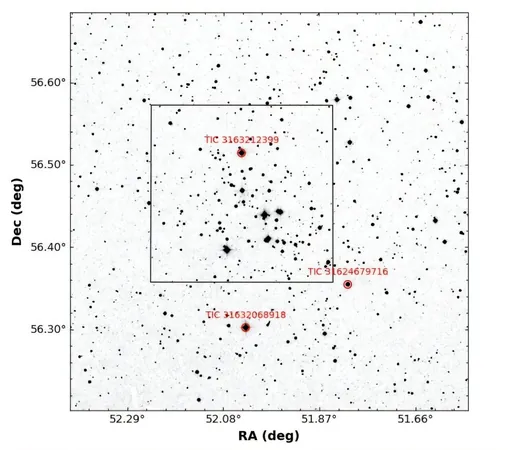
Astronomers Uncover Exciting New Stars in King 6 Cluster!
2025-05-05
Author: Yu
Astronomical Breakthrough: Three Newly Discovered Variable Stars!
In an exciting twist for stargazers and scientists alike, astronomers using the 104-cm Sampurnanand optical telescope have made a groundbreaking discovery in the open cluster King 6. Their detailed photometric observations, recently shared on the arXiv pre-print server, revealed three new variable stars in this intriguing region of space.
What Are Open Clusters?
Open clusters are fascinating groups of stars born from the same giant molecular cloud, bound together by their gravitational pull. So far, more than 1,000 of these stellar clusters have been cataloged in our Milky Way, and the quest to find more continues. Expanding our knowledge of these clusters is critical to understanding the galaxy's formation and evolution.
Meet King 6: A Mysterious Stellar Cluster!
Located approximately 2,357 light-years from Earth, King 6 has long been shrouded in mystery. Previous studies only hinted at its characteristics—like a color excess of 0.55 and an estimated age of 200 million years—leaving many questions unanswered. This is why a team led by Vaibhav Kumar Pandey from Deen Dayal Upadhyaya Gorakhpur University set out to explore this cluster more closely.
A Stellar Discovery!
Thanks to valuable data from ESA's Gaia satellite and NASA's Transiting Exoplanet Survey Satellite (TESS), Pandey and his team identified three new variable stars: TIC 31624679716, TIC 31632068918, and TIC 3163212399. These stars exhibit magnitude variations of approximately 0.02, 0.01, and 0.04, with pulsation periods of 46.70, 47.92, and 37.56 hours, respectively, and temperatures reaching between 10,500 and 11,050 K.
Understanding the Stars: Classification and Properties!
The newly found stars fall under the category of slow pulsating B-type (SPB) variables, known for their longer periods and subtle brightness changes. Beyond these discoveries, the researchers gleaned more insights into King 6 itself, revealing a radius of about 6.45 light years and a tidal radius of 10.37 light years.
New Insights into King 6!
Significantly, the new research suggests King 6 is more massive than previously thought, with a mass function slope around 0.57, indicating a possible mass segregation within the cluster. Moreover, the estimated relaxation time of about six million years implies that King 6 is dynamically relaxed—a significant factor for understanding its evolution.
This innovative research not only expands our catalog of stars but also enhances our understanding of how open clusters like King 6 function and evolve over time. Stay tuned as we watch the cosmos unfold!



 Brasil (PT)
Brasil (PT)
 Canada (EN)
Canada (EN)
 Chile (ES)
Chile (ES)
 Česko (CS)
Česko (CS)
 대한민국 (KO)
대한민국 (KO)
 España (ES)
España (ES)
 France (FR)
France (FR)
 Hong Kong (EN)
Hong Kong (EN)
 Italia (IT)
Italia (IT)
 日本 (JA)
日本 (JA)
 Magyarország (HU)
Magyarország (HU)
 Norge (NO)
Norge (NO)
 Polska (PL)
Polska (PL)
 Schweiz (DE)
Schweiz (DE)
 Singapore (EN)
Singapore (EN)
 Sverige (SV)
Sverige (SV)
 Suomi (FI)
Suomi (FI)
 Türkiye (TR)
Türkiye (TR)
 الإمارات العربية المتحدة (AR)
الإمارات العربية المتحدة (AR)